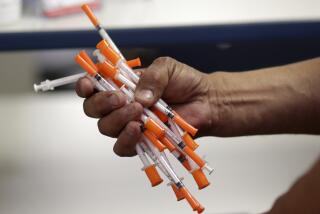This Is Not a Test
San Diego County officials used computer simulation last year to see how well they would respond to a bioterrorism attack. The answer: not very. In the simulation, thousands of people became violently ill, quickly overwhelming hospitals.
In an Orange County terrorism drill at Edison Field in Anaheim last year, law enforcement and other emergency agencies won praise from the Department of Defense for their rapid response. But communication on the county’s troubled new radio system was poor, and several hospitals proved inadequately prepared to treat victims of a chemical or biological attack.
In Los Angeles County, it doesn’t take a computer simulation or a drill to uncover the weaknesses of emergency rooms. Crowding on any given weekend forces at least some to temporarily shut their doors to incoming ambulances. The county’s chronically underfunded public health system, saddled with a severe nursing shortage, an astronomical number of uninsured residents and the county’s sheer size--10 million people across 4,000 square miles--struggles to get by in ordinary times.
Southern Californians have reason to be alarmed at the region’s lack of preparedness. But the most important thing that ordinary residents, who make up the front line in this war against civilians, can do is not panic. Consider the very long odds of coming to harm. Channel anxiety into stocking up on emergency supplies, which is always a good idea in earthquake country, but not gas masks or antibiotics, which wouldn’t do any good and could do harm. Residents can find information about anthrax through the California Department of Health Services’ toll-free information line, (800) 550-5234, or its Web site ( www.dhs.cahwnet.gov/bioterrorism ).
Family doctors and emergency room physicians throughout Southern California need to educate themselves on how to detect anthrax and other bioterrorism agents. Unlike an earthquake or a bomb explosion, everyone wouldn’t necessarily know at once that an attack had been launched. There is no simple test for anthrax. Only by detecting--and reporting--identifiable symptoms could public health officials see a pattern and take action. County health officials are helping train doctors, as is the California Medical Assn. ( www.cmanet.org ).
To local public officials--mayors, city council members, county supervisors, police chiefs and sheriffs--falls the task of deciding what needs to be done and how to pay for it, from buying basic protective gear to increasing laboratory capacity. For that they will need steady advice from experts--and more federal funding. Los Angeles County supervisors on Tuesday passed a $6.8-million security measure that included some health funding.
However, the most crucial steps in dealing with bioterrorism are the same as in dealing with any other emergency: establishing a clear chain of command and straightforward communications. Southern Californians have the chance to learn from mistakes made on the East Coast, where federal, state and local agencies in responding to reports of mailed anthrax gave contradictory directions or, worse, no directions at all.
And the region needs a Lucy Jones for bioterrorism. Angelenos trust Jones, the seismologist in charge of the U.S. Geological Survey office for Southern California, as a source of calm information after an earthquake. The kind of cooperation that will be needed in a bioterrorism attack will not be possible without trust.
Finally, the public needs to see its officials move with an urgency not usually seen in government bureaucracies. This is not a test.
More to Read
Sign up for Essential California
The most important California stories and recommendations in your inbox every morning.
You may occasionally receive promotional content from the Los Angeles Times.










